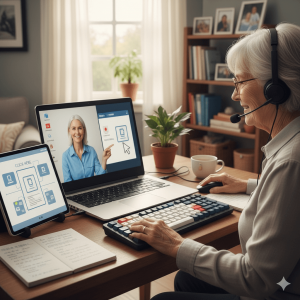Learn Basic Computer Skills

At Computer Rescue Derby, I provide patient, one-to-one computer skills tuition designed to help you build confidence and make technology work for you.
Whether you’re an absolute beginner feeling overwhelmed, have been given a new device, or just want to feel more comfortable with everyday tasks, I’m here to help. My lessons take the mystery out of computing, focusing on the practical, essential skills you need for daily life in a clear and understandable way.
It’s easy to feel left behind by fast-moving technology or confused by technical jargon. My approach is simple: jargon-free, step-by-step explanations tailored to your personal pace and interests. There’s no set curriculum; we focus on what you want to learn, whether that’s understanding where your files are saved, sending an email to family, or simply knowing how to find information online.
My tuition covers all the fundamentals, from the absolute basics of using a mouse and keyboard to navigating the desktop. We can cover practical skills like organising your documents and photos, browsing the internet safely, and communicating with friends and family through email and video calls. A key part of this is learning how to stay safe online, spot potential scams, and protect your personal information.
I understand that it can be frustrating or even intimidating when a computer doesn’t do what you want. That’s why I offer friendly, local tuition here in Derby, where you can ask any question—no matter how small—in a supportive, pressure-free environment. My single goal is to give you the skills and confidence to use your computer independently and safely. If you’re looking for basic computer lessons in Derby for yourself or a family member, contact Computer Rescue Derby, and I’ll help you get started on your journey to becoming a confident computer user.
Core Navigation Skills
Controlling the Pointer: Mastering the mouse/trackpad: left-click (to do something), right-click (to see options), and how to scroll up and down pages.
The Desktop and Icons: Identifying what’s on the screen. How to open a program by double-clicking an icon.
The Start Menu (Windows) / Dock (Mac): Using the main menu to find and launch any application on the computer.
Managing Windows: How to minimise, maximise, and close application windows. How to switch between different programs that are open at the same time.
Working with Files & Folders
Understanding Files and Folders: Using the analogy of paper documents (files) and filing cabinets (folders).
Creating Folders: How to make new folders inside ‘Documents’ or ‘Pictures’ to keep things tidy.
Saving and Finding: How to save a file (like a letter or photo) and, most importantly, choose where it goes so you can find it again later.
Moving and Deleting: How to move files into folders using drag-and-drop, and how to delete files by moving them to the Recycle Bin/Trash.
Using the Internet and Web Browsers
Effective Searching: How to use a search engine like Google to find information, recipes, or news.
Using Tabs: How to have several websites open at once in different tabs and switch between them.
Bookmarks and Favourites: How to save a favourite website (like a news site or email login page) for quick one-click access later.
Copy and Paste: A key skill. How to copy text from a website and paste it into an email or a document.
Essential Communication
Composing and Replying to Emails: How to write a new message, reply to one you’ve received, and add a subject line.
Sending Attachments: How to attach a photo or a document to an email for sharing.
Opening Attachments Safely: How to open attachments you receive and being cautious if they look suspicious.
Making a Video Call: A simple walkthrough of joining a call on a service like Zoom, Skype or FaceTime, including how to mute/unmute your microphone and turn your camera on/off.
Security Essentials: Stay Safe Online
Creating Strong Passwords: Understanding what makes a password strong (length, mix of characters) and why you shouldn’t use the same one everywhere. The “passphrase” method (e.g., “Three-Purple-Hats!”) can be very effective.
Spotting Scam Emails (Phishing): Learning the key signs: urgent or threatening language, spelling mistakes, generic greetings (“Dear Customer”), and requests for personal information. The golden rule: your bank will never email you asking for your password or PIN.
Safe Web Browsing: Looking for the padlock icon in the browser’s address bar on shopping or banking websites. Being highly suspicious of pop-up windows that claim you have a virus and tell you to call a phone number.
Common Everyday Tasks
Writing a Simple Document: Using a program like Microsoft Word or WordPad to type a letter, change the text size and colour, and save it.
Managing Photos: Finding where your photos are stored, viewing them as a slideshow, and maybe selecting a favourite to set as your desktop background.
Basic Settings: How to adjust the volume, connect to headphones, or change the screen brightness.
- Printers: Setting up printers to home networks, learning how to print from Word, excel and online. How to do basic printer maintence using the providers software tools. documents
Get in touch
Details
MONDAY – 9AM to 8PM
TUESDAY – 9AM to 8PM
WEDNESDAY – 9AM to 8PM
THURSDAY – 9AM to 8PM
FRIDAY – 9AM to 8PM
SATURDAY – 10AM to 4PM
SUNDAY – 10AM to 4PM
PHONE : 07508606171
EMAIL : info@crderby.co.uk
COMPUTER RESCUE DERBY
10 QUEENSBURY PARK DRIVE
SHELTON LOCK, DERBY
DE24 9SG
PLEASE NOTE : VISITS BY APPOINTMENT ONLY
